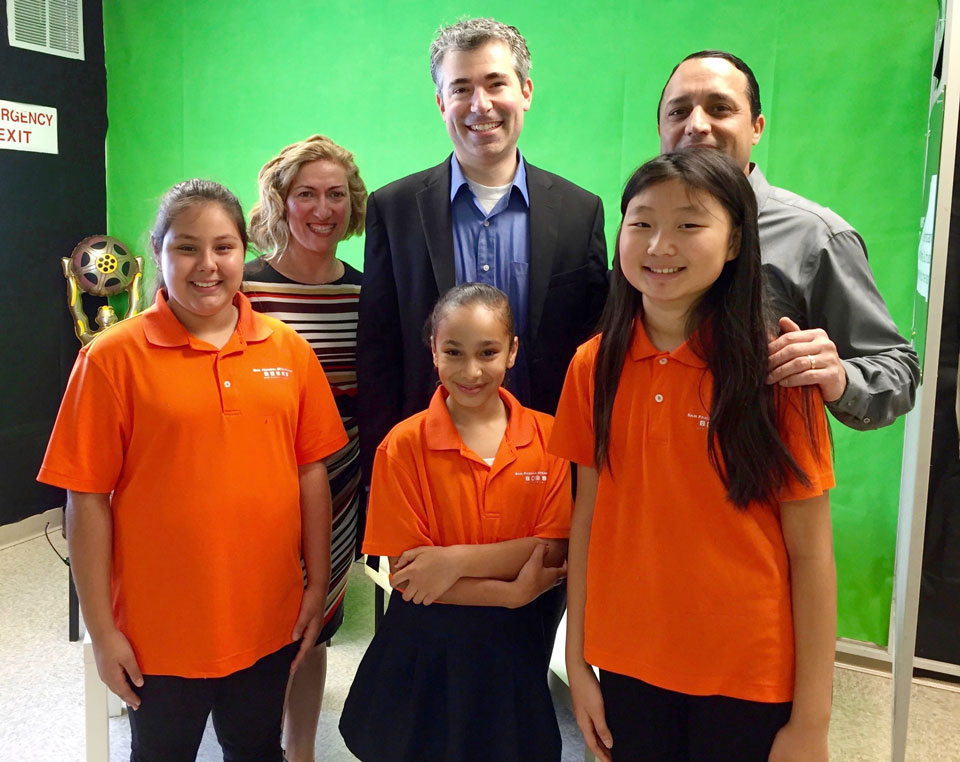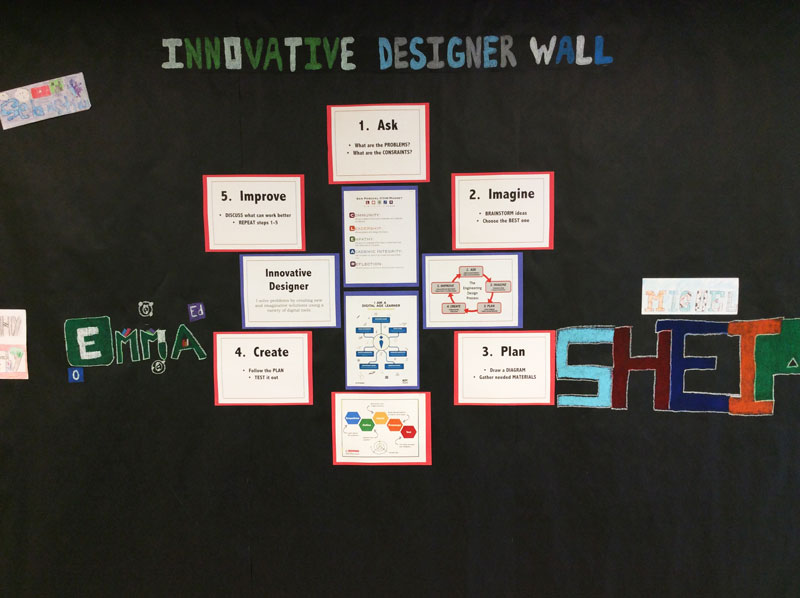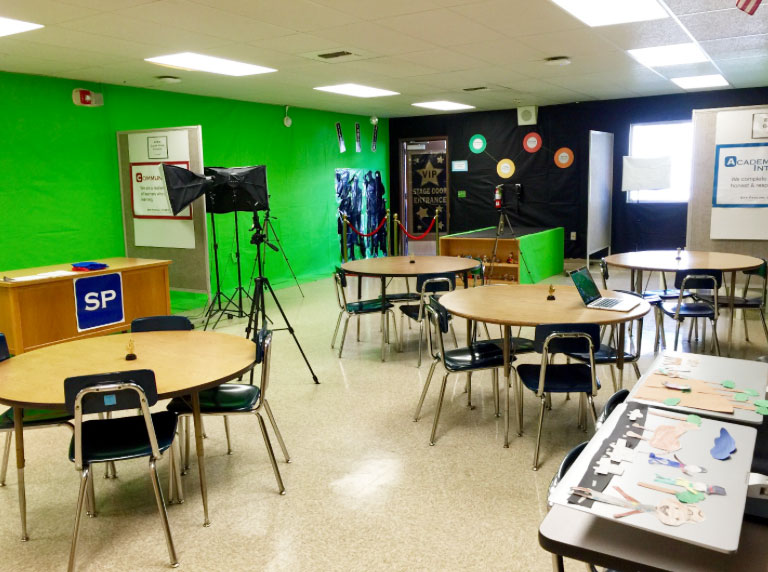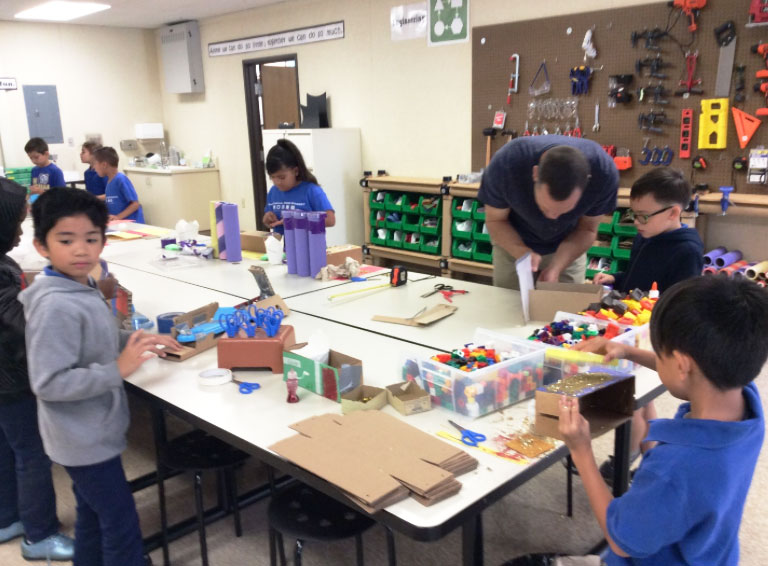How the Students of San Pascual STEAM Magnet Have Harnessed the Power of the ISTE Standards
by Daniel Miyake, 5th Grade Teacher at San Pascual STEAM Magnet
With the poise and confidence of a seasoned journalist, San Pascual STEAM Magnet (SPSM) student leader, Tatianna, sat down in the school’s newly designed Media Lab in May of 2018 to interview Richard Culatta, the CEO of the International Society for Technology in Education (ISTE). As the discussion progressed, CEO Culatta began to sense that the 10 year-old fourth grader he was being interviewed by had an in-depth understanding of the ISTE Student Standards, so he turned the tables on her to get her opinion of where she felt the direction of educational technology was headed in the future.
“Can I ask you a question?” inquired the renowned CEO. “What is one thing you would like to see different about the future?”
“Well,” responded the 10 year-old without hesitation, “I would like to see our COMMUNITY come together through the use of technology, and come together more than it already is.”
It is such an unwavering belief in the power of community that has driven this young fourth grader, and the students of SPSM, to believe that they are empowered learners and leaders who will design the future.
Empowered Learners
Tatianna, like all of the students at SPSM, feels empowered by the learning that took place while SPSM actively participated in ITI’s Practitioner School 1.0 and 2.0 initiatives. Students are now ready to participate in Practitioner Schools 3.0 with a focus on the ISTE Standard, Innovative Designer.
 Consequently, students in Tatianna’s 5th grade class have been asked to identify a problem they imagine occurring in 2050, and then design a product to solve that problem. Because this class believes they are empowered learners, they have developed a mindset that will enable them to leverage technology to design solutions to the problems they imagine arising in the world of 2050.
Consequently, students in Tatianna’s 5th grade class have been asked to identify a problem they imagine occurring in 2050, and then design a product to solve that problem. Because this class believes they are empowered learners, they have developed a mindset that will enable them to leverage technology to design solutions to the problems they imagine arising in the world of 2050.
To discover the problems they chose to study, students did research on what experts believe will be some of the main global issues confounding the world in 2050. They empathized with the experts, and began to think about their own lives and passions in order to come up with a research focus. The result was extremely authentic.
A student who has a passion for space science has decided to develop a product called Edium, which is a new element that can combine with oxygen to allow humans to breathe on the moon without a spacesuit. Another student is attempting to design an X-ray machine that will help doctors detect dementia early on in life because she had a relative who acquired the disease. Meanwhile, a student who is passionate about sports and exercise is designing a wristband that will shut down all technological devices if a required amount of exercise has not been reached. And, finally, a student who realizes that water shortage will be a reality in 2050, is trying to convince all of us that he can create water! His company, “Drink Well,” will engineer water and solve all of southern California’s future water issues. Now, that’s entrepreneurship at its finest!
 Upon visiting the classroom, you will see an “Innovative Designer Wall” across the entire side of the room where students are posting their company logos and all prototypes they are creating to market their innovative products.
Upon visiting the classroom, you will see an “Innovative Designer Wall” across the entire side of the room where students are posting their company logos and all prototypes they are creating to market their innovative products.
As educators, we are asking the students to become innovative designers, so we must do the same! We too must possess an innovator’s mindset to give students the opportunity to authentically harness and leverage the multitude of technological resources available to them so they can acquire the digital age skills necessary to be the global collaborators and leaders of the future.
The Power of Community
Immediately upon entering this classroom, a student leader will enthusiastically welcome you to the learning community, and you will be struck by the passion the students have for creatively communicating their ideas. The construction of knowledge is readily apparent as students use each other as valuable resources in their quest to design solutions to their problems.
 Students recognize that, as innovative designers, they must become effective global collaborators who can tap into community resources beyond their classroom. Consequently, they discuss ways to work with the Instructional Technology Facilitator (ITF) in the Media Lab on the commercial they are producing to sell their product; they articulate ideas for utilizing the Makerspace Design Lab to engineer a 3-D model of their product; they ask a student who is a leader in graphic design for help with their product logo and construction of their company website; they implore fellow classmates to come to the “Innovative Designer Parent Night” to gather new ways of thinking from family members; and they discuss ways to contact professionals in the community such as, scientists, astronauts, and professors they can empathize with to better understand their futuristic problems. This relentless pursuit of knowledge is made possible because the students have acquired an innovative designer’s mindset that recognizes the power of community; and because their teachers have created opportunities for this type of engagement and learning.
Students recognize that, as innovative designers, they must become effective global collaborators who can tap into community resources beyond their classroom. Consequently, they discuss ways to work with the Instructional Technology Facilitator (ITF) in the Media Lab on the commercial they are producing to sell their product; they articulate ideas for utilizing the Makerspace Design Lab to engineer a 3-D model of their product; they ask a student who is a leader in graphic design for help with their product logo and construction of their company website; they implore fellow classmates to come to the “Innovative Designer Parent Night” to gather new ways of thinking from family members; and they discuss ways to contact professionals in the community such as, scientists, astronauts, and professors they can empathize with to better understand their futuristic problems. This relentless pursuit of knowledge is made possible because the students have acquired an innovative designer’s mindset that recognizes the power of community; and because their teachers have created opportunities for this type of engagement and learning.
Moreover, as mentioned above, we as educators must think of ways to creatively involve the community in our efforts to facilitate learner agency. While participating in Practitioner Schools 2.0 during the 2017-2018 school year, the ITI team asked SPSM to accept an important challenge: Seek out opportunities to collaborate with other like-minded schools and educators. The Principal of SPSM, Paula Cordoba, took this charge seriously. She thought of and designed a series of creative ways for the students of SPSM to share their learnings with the community. As a result, as in past years, the students of SPSM will showcase their learning during a STEAM Symposium that will take place on the SPSM campus in October of 2018.
in our efforts to facilitate learner agency. While participating in Practitioner Schools 2.0 during the 2017-2018 school year, the ITI team asked SPSM to accept an important challenge: Seek out opportunities to collaborate with other like-minded schools and educators. The Principal of SPSM, Paula Cordoba, took this charge seriously. She thought of and designed a series of creative ways for the students of SPSM to share their learnings with the community. As a result, as in past years, the students of SPSM will showcase their learning during a STEAM Symposium that will take place on the SPSM campus in October of 2018.
Our Vision is CLEAR
Since its inception in the Fall of 2016, SPSM has been driven by a CLEAR Vision that promotes Community, Leadership, Empathy, Academic Integrity, and Reflection. This vision has enabled the school to align systems and structures in place at the school level with those in place at the District level.
Ultimately, as Tatianna emphatically states, “…the CLEAR Vision is the foundation of our school. Without it, we would not have the mindset to innovate and create…and wouldn’t feel empowered to use resources such as the ISTE Standards to empathize with the community! So never forget, at San Pascual STEAM Magnet, our vision is… CLEAR!”
View: San Pascual STEAM Magnet Interview with ISTE CEO Richard Culatta


